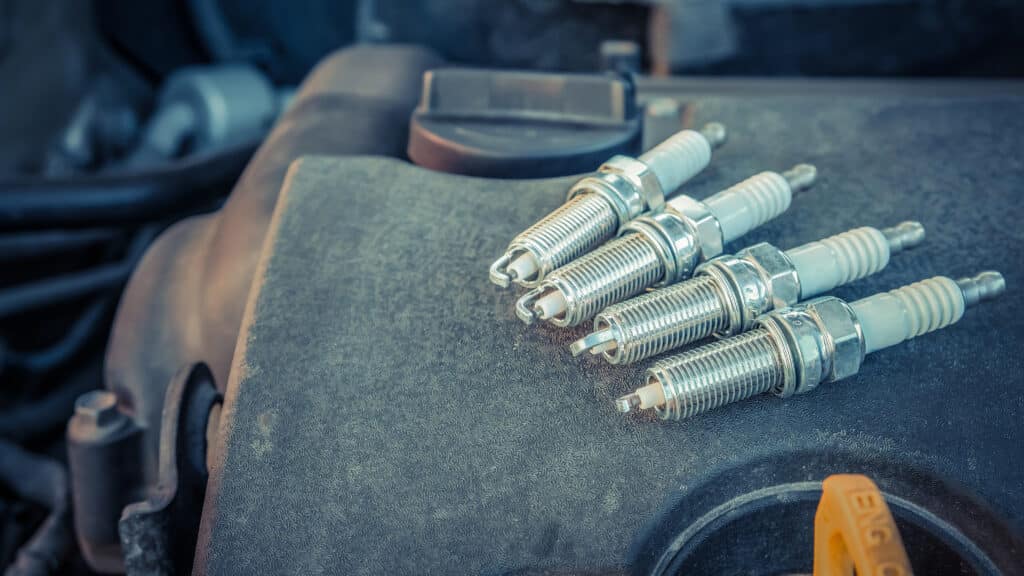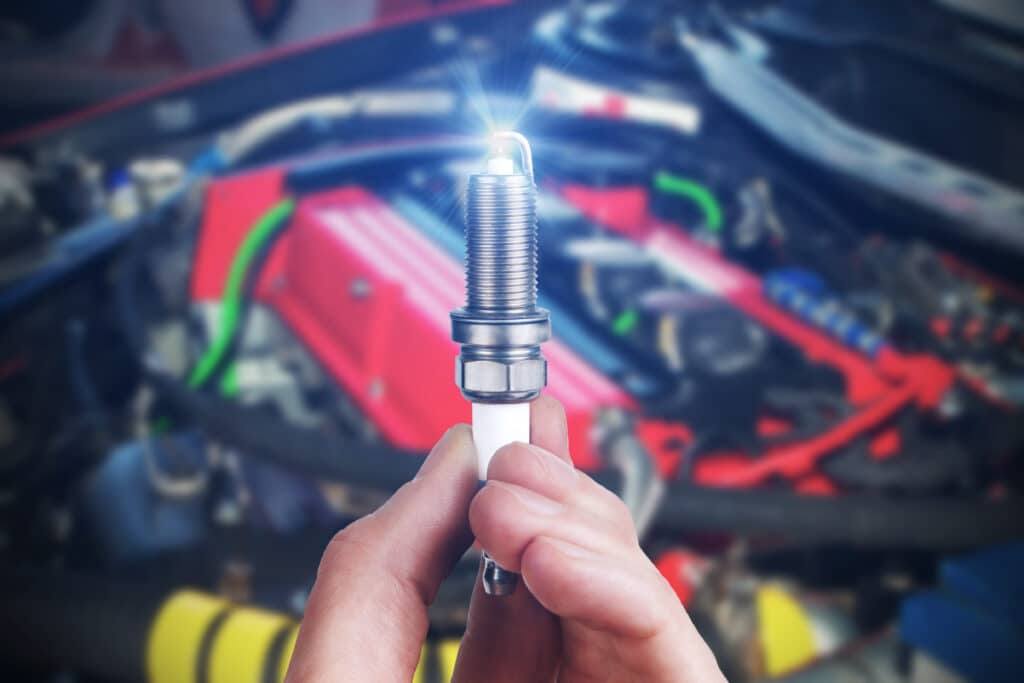You want to know how a spark plug works? Then check out our article here and learn more about the importance of this component.
What is a spark plug?
The biggest difference between diesel and gasoline engines is that a gasoline engine is spark ignited. This means that the gasoline engine cannot ignite the air-fuel mixture itself like the diesel engine.
For this reason, it is necessary in the gasoline engine that in the “compression stroke” the air-fuel mixture combustion is initiated by an electric spark.
Now the spark plug comes into play, because the main task of the spark plug is to generate exactly this electrical spark that is necessary for combustion.

What do spark plugs do?
In order for the spark plug to generate the electrical spark at all, a high voltage must first be provided by the ignition coil. If the high voltage of the ignition coil is applied, the current jumps over to the electrodes of the spark plug and the electrical ignition spark is generated.
What requirements must a spark plug meet?
To ensure faultless and, above all, environmentally friendly engine running, several requirements must be met. But one of the most important points here is that the perfect amount of air and fuel is available. But the ignition spark must also be precise and at the right time.
For this reason, the spark plug must meet the highest requirements. In a four-stroke engine, the spark plug must produce a spark 500-3600 times per minute. Even in very hot or cold temperatures, the spark plug must function properly.
Modern spark plugs are capable of ensuring combustion with as few pollutants as possible without misfiring.
Different types of spark plugs
Spark plugs with multiple ground electrodes
In order to be able to achieve a longer replacement interval with conventional spark plugs, these are equipped with up to four ground electrodes.
Due to the ever-changing temperatures, the ignition spark always jumps over at a different ground electrode.
This distributes the ignition spark to the up to four installed ground electrodes, where wear is reduced.
Hybrid spark plugs
The biggest disadvantage of modern gasoline engines with direct injection is that the spark plugs can soot very quickly depending on the driving profile.
For this reason, there are extra spark plugs for precisely these engines, which have one large and two small ground electrodes. The two smaller ground electrodes are located on the side of the spark plug and become active if the engine control unit detects that the spark plug is sooty. Simply you can say that this type of spark plug can clean itself.
LPG/CNG spark plugs
Gas engines (CNG, LNG or LPG) usually require different spark plugs than gasoline engines. In some cases, other ignition coils are also needed.
The reason for this is that the combustion of a gas mixture requires a higher ignition voltage. In addition, the risk of the ignition spark breaking off at high engine speeds is higher than with gasoline combustion.
How to tell if a spark plug is bad?
The best and easiest test for this fault is to replace the spark plug crosswise. This means taking the faulty spark plug from the cylinder and fitting it to another cylinder. In turn, the spark plug from the latter cylinder is installed on the previously faulty cylinder. When this is done, the fault memory should be cleared and a test drive made until the fault reappears. Then the vehicle should be read out again. If the fault has now migrated to the other cylinder, this means that this spark plug is really defective. If the error has not migrated, the same must be tested with the spark plug. Here, too, a test drive must be carried out again and then the fault re-evaluated.
How long do spark plugs last?
A spark plug should usually be changed every 30,000 to 60,000 kilometers or every 2 to 4 years, depending on the type of engine. For vehicles that use gas as fuel, it may also be necessary to change the spark plugs earlier, depending on the case.
We recommend that you follow the vehicle manufacturer’s recommendations or the prescribed replacement interval.
How to change spark plugs?
Normally, it is no problem to change the spark plugs yourself. As a rule, no special tools are required here. In this video you can see how to change the spark plugs on a vehicle using a BMW as an example.
Which spark plug belongs to which engine?
The right spark plug for an engine depends on various factors, such as the displacement, the power and the type of construction. Here are some important factors for the selection of a spark plug:
- Thread size: The spark plug thread size must match the diameter and length of the bore and thread area of the cylinder head.
- Power: The power of the spark plug must meet the requirements of the engine. Higher output spark plugs may be required to support higher engine speeds and higher horsepower.
- Design: There are different designs of spark plugs, such as conical, flat and double-sided electrodes. The type of spark plug must meet the requirements of the engine.
To ensure that the correct spark plug is used, it is best to follow the vehicle manufacturer’s recommendations.
How to gap spark plugs?
To gap spark plugs, you need to adjust the distance between the center electrode and the ground electrode to a specific measurement. This measurement is called the “gap size” and is usually specified by the vehicle manufacturer or the spark plug manufacturer. To gap the spark plugs, you can use a spark plug gapping tool, which is a small tool that fits over the spark plug and has a gauge to measure the gap. Here are the steps to gap your spark plugs:
- Remove the spark plug from the engine.
- Check the specified gap size in your vehicle owner’s manual or the spark plug manufacturer’s specifications.
- Place the spark plug in the gapping tool and adjust the gap by carefully bending the ground electrode with a small screwdriver or pliers until the gap is the correct size.
- Repeat the process for each spark plug.
- Reinstall the gapped spark plugs in the engine.
Note: Make sure to handle the spark plugs with care and wear gloves to avoid damaging the center electrode.


